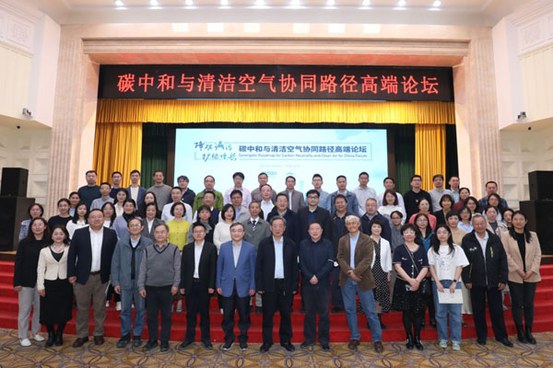Air Standards and Co-Control Are Key to Carbon Neutrality in China, Experts Say
In March 2023, with the support of Energy Foundation China (EF China), the China Clean Air Policy Partnership held its forum in Beijing on China’s synergetic roadmap for carbon neutrality and clean air. Experts in the fields of climate change and air pollution control gathered together to discuss how to reduce carbon emissions and air pollution with the same set of control measures including digitalization and energy and economic transformation.

Experts attending the meeting on March 30, 2023.
Photo by the China Clean Air Policy Partnership Secretariat
In his opening speech, Hao Jiming, Academician of the Chinese Academy of Engineering and Professor at the Tsinghua School of Environment, said that to achieve decarbonization and air improvement at the same time, China needs to transform its industry, energy, transportation, and land use structures, as well as synergistically managing fine particulate (known as PM2.5) and ozone pollution. China also needs to speed up the revision of ambient air quality standards, and combine the stricter standards with decarbonization efforts, he said.

Professor Hao Jiming delivers his opening speech on March 30, 2023.
Photo by the China Clean Air Policy Partnership Secretariat

Zou Ji, CEO and President of EF China, makes his opening speech on March 30, 2023.
Photo by the China Clean Air Policy Partnership Secretariat
Zou Ji, CEO and President of EF China, said in his opening speech that clean air quality is a first priority in China’s endeavor for the harmony between humanity and nature. In the new era of transitioning China’s energy mix, environmental protection and decarbonization are no longer obstacles to the economy, but the driving forces in a new growth model, he said. China should link short-term counter-cyclical economic policy with long-term “cross-cyclical” strategy for decarbonization, according to him, who also said the next step should be introducing market tools and private investment to update and disseminate pollution and carbon reduction technology.

Liu Bingjiang, Director-General of the Air Quality Department of China’s Ministry of Ecology and Environment, makes his speech on March 30, 2023.
Photo by the China Clean Air Policy Partnership Secretariat
During the presentation by Liu Bingjiang, Director-General of the Air Quality Department of China’s Ministry of Ecology and Environment, on criteria pollutant and carbon reduction of energy infrastructure, he reviewed the achievements of China’s blue sky campaign in the “golden era” of the last 10 years, which saw near-zero growth in coal consumption as structural changes drove China’s national average PM2.5 concentration down to less than 30 micrograms per cubic meter of air. During the previous period of 2003–2012, economic growth was coupled with worsening air pollution, with a 129 percent increase in coal consumption, he said. In particular, he analyzed the experience of comprehensive air quality improvement and carbon reduction in the Beijing-Tianjin-Hebei region since 2013, and highlighted coal consumption in the non-electricity sector as the major challenge for the next step. “We must continue to improve the construction of clean energy infrastructure, and to leverage the synergistic approach,” he concluded.

He Kebin, Academician of the Chinese Academy of Engineering and Head of the Tsinghua Institute of Carbon Neutrality, makes his speech on March 30, 2023.
Photo by the China Clean Air Policy Partnership Secretariat
He Kebin, Academician of the Chinese Academy of Engineering and Head of the Tsinghua Institute of Carbon Neutrality, focused his speech on how digital tools can enable collaborative oversight on carbon neutrality and clean air issues. He said that information—for topics such as pollution and carbon reduction; the cost of emission control measures; energy, environmental, and health inputs and outputs; infrastructure; and economics—need to be quantified with digital tools and data, which can facilitate the collaborative decision-making and evaluation of air and carbon issues.
Zhang Yuanhang, Academician of the Chinese Academy of Engineering and Professor at the Department of Environmental Sciences and Engineering of Peking University; Jiang Kejun, Researcher of the Institute of Energy Research of the Chinese Academy of Macroeconomics; Wang Zifa, Researcher of the Institute of Atmospheric Physics of the Chinese Academy of Sciences; Lei Yu, Director and Researcher of the Institute of Atmospheric Environmental Planning of the Academy of Environmental Planning of the Ministry of Ecology and Environment also made speeches on topics including atmospheric self-cleaning and carbon reduction, energy and economic transformation pathways, and atmospheric environment forecasting and tracing used in carbon inversion calculations.

Liu Xin, Director of the Environmental Management Program of EF China, chairs the meeting on March 30, 2023.
Photo by the China Clean Air Policy Partnership Secretariat
Liu Xin, Director of the Environmental Management Program of EF China, closed the meeting by saying that, based on China’s great progress in reducing pollution and carbon emissions driven by clean air efforts over the past decade, the future priorities lie in a mid-term assessment of the 14th Five-Year Plan period progress, a summary of the 10 years of experience, innovative new co-control analysis tools, air quality standards upgrade, technological innovation of industrial pollution and carbon mitigation, new local oversight mechanisms, and the strengthened implementation of co-control systems.




